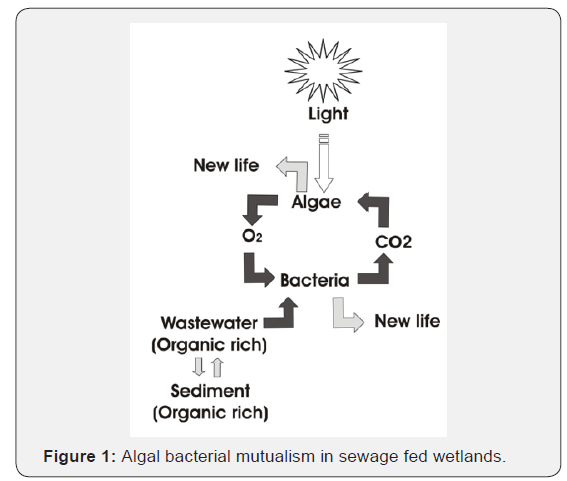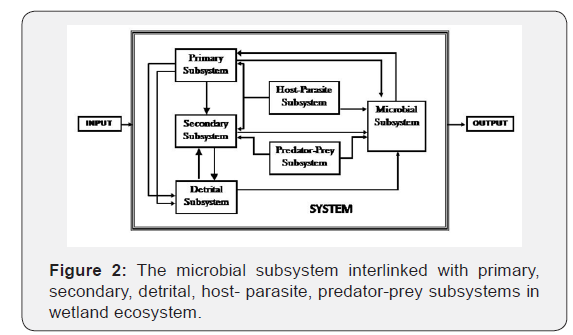The Self Purification Mechanism of Tropical Sewage- Fed Wetlands: the Theory of Microbial Subsystem
Jana BB*
International Centre for Ecological Engineering, University of Kalyani, India
Centre for Environmental Protection and Human Resource Development, University of Kalyani, India
Submission: December 20, 2018; Published: May 23, 2019
*Corresponding author: BB Jana, International Centre for Ecological Engineering, University of Kalyani, and Centre for Environmental Protection and Human Resource Development (KSI), B-10/289, Kalyani- 741235, West Bengal, India
How to cite this article: Jana BB. The Self Purification Mechanism of Tropical Sewage-Fed Wetlands: the Theory of Microbial Subsystem. Adv Biotech & Micro. 2019; 14(1): 555878. DOI: 10.19080/AIBM.2019.14.555878
Abstract
The microbial subsystem is one of the important regulatory adaptive features of wetlands to bring out the perturbed habitat into normal or subnormal state mediated through a series of different interconnected, interdependent, interlinked and coordinated subsystems causing multiple interactions in a symbiotic way among themselves. As a result, the highly heterotrophic and disastrous state of sewage fed wetlands is transformed into eutrophic or mesotrophic benign environment conducive to fish culture or other economy driven activities. The microbial subsystem along with other subsystems work as a fully interactive network for saving the system from perturbation. In the microbial subsystem, most of the anaerobic pathogens are reduced due to oxygenation effects caused by solar driven photosynthesis of microalgae and aquatic plants, natural die-off for starvation or predation, sedimentation, filtration and adsorption, etc. Biogeochemical cycling bacteria, on the other side, contribute in the primary productivity through nutrient cycle activities.
Keywords: microbial subsystem; Environment, Fish culture; Oxygenation; Aquatic plants; Sedimentation; adsorption; Biogeochemical cycling bacteria; Staphylococcus aureus; Shigella; Enterococcus; Escherichia coli
The wetlands
Wetlands, covering nearly 5 - 8% of the terrestrial landscape, form a heterogeneous spectrum of aquatic habitats, water resources, hot spots of biodiversity, mitigation of flood, groundwater replenishment, pollution and global warming, coastal protection as well as provide a wide range of ecosystem services especially for livelihood of millions in the tropical world. A classic example of the function of wetland in the treatment of municipal sewage cum fish culture is the East Kolkata wetlands and Kalyani Sewage Treatment Plants [1,2] where large section of poor people earn their livelihoods following the ecological principles of self-purification mechanism of wetlands. Due to immense carbon sequestration potentials by aquatic plants and microalgae, the world’s wetlands are considered significant source of carbon sinks on the order of 830 Tg/year [3]. However, high rates of anaerobic microbial respiration of sedimentary pools of organic carbon under reduced and saline conditions have negative feedback to climate change by emitting CO2 to the atmosphere [4]. Notwithstanding the manifold positive impacts of wetlands on environment have led to argue that wetland should not be destroyed because of Greenhouse Gas (GHG) emissions under limited conditions [3] Wetlands are, however, under great pressure of the decline due to anthropogenic interference especially the urbanization.
Heavy input of untreated municipal sewage containing mixtures of sludge and other organics has been ideal media for luxuriant growth of aerobic and anaerobic microbial coenosis capable of degrading organic compounds, remove, immobilize, and/or transform different contaminants, pharmaceuticals, petrochemicals, chlorinated solvents, pesticides, explosives, heavy metals, and radio-nuclides, etc. [2, 5].
The chemical characteristics of wastewater are the hotspots for microbial community comprising of bacteria, viruses, protozoa, fungi, etc. Among them, opportunistic pathogens (Enterobacter cloacae, Enterococcus faecalis, Escherichia coli, Klebsiella pneumoniae, Proteus vulgaris or Pseudomonas aeruginosa) cause different infections and the obligate pathogens (Salmonella typhii, Staphylococcus aureus, Shigella, Enterococcus, Escherichia coli) are causative agents for gastro-enteric diseases. Such highly heterotrophic and disastrous condition is highly detrimental to environmental and human health. Self-purification mechanism of wetlands enables the shifting of such highly eutrophic to mesotrophic benign environment following ecological principles of mutual relationships between heterotroph and autotrophs (Figure 1).

The ecosystem
Aquatic ecosystem is a fully interactive and information network and immensely complicated ones linked by different members maintained in symbiotic and holistic manner to maintain the homeostatic function. The wetland ecosystem comprised of primary, secondary, detrital, host-parasite, predator-prey and microbial subsystems that are interdependent and interconnected with each other following the feedback and redundancy behavior mechanisms (Figure 2). All these subsystems are interconnected, interdependent, interlinked, interactive and function as a unit in an integrated, coordinated and holistic manner and maintain a homeostatic balance through physical and chemical communication flows in a cybernetic system.

Figure 2. The microbial subsystem interlinked with primary, secondary, detrital, host- parasite, predator-prey subsystems in wetland ecosystem. Wetland’s self-purification or stability refers to the response of a wetland system to a disturbance or perturbation. Hence, it is the adaptive capacity to conserve the ecosystems and their diversity from disastrous effects. Though two types of stability (resistant and resilience) are responsible for homeostasis, the resilience stability is more effective to recover the system to its original state after disturbance. This property is the resilience that is capable of repairing the damage caused by perturbation within the range of limit and bring back to normal or subnormal state over time. Redundancy or holism where more than one species capable of performing a given function is also capable to restore.
Microbial subsystem

Microbial subsystem especially the rhizosphere (subsurface zone of interaction between root structures and microbial communities) are considered as a “sunlight driven hotspot”. The dynamic and heterogenous microbial communities are most dynamic and often vary over time and space in their structure and functions. The organic compounds are transformed through several biochemical reactions during the active waste stabilization processes such as hydrolysis by extracellular enzymes, oxidation, cell synthesis and endogenous respiration (Figure 3). The rate of molecular synthesis is directly dependent upon the ability of microorganisms to degrade organic substrates. Degradation of organic matter is performed in both aerobic and anaerobic pathways and eventually the organic matter is converted into CO2, H2O, NH3, NO3 and SO4. It is evident that most pathogens (Escherichia coli, Staphylococcus aureus and coliforms) are removed due to natural die-off for starvation or predation, sedimentation, filtration and adsorption in constructed wetlands [6] or are significantly reduced when exposed to highly aerobic condition resulting from solar energy driven photosynthesis of microalgae and aquatic plants.
The role of microbial subsystem is crucial in maintaining the stability or purification mechanism. The microbial subsystem with multi enzyme bacterial complex and high metabolic activities are responsible for degradation of fatty acids, amino acids and other biological materials [7], which, in turn, boosted the primary productivity mediated through the degradation kinetics of nutrient cycling bacteria. However, the natural functioning of self-purification operates within the range of limit. It is location specific depending on biological and environmental interacting factors.
The tropical wetlands
Tropical wetlands differ markedly from temperate ones in the framework of their structural and functional metabolism because of significant differences in temperature regime, intensity and duration of light, depth, physicochemical milieu and diversity and abundance in biotic community between the two contrast environments. Because of more carbon turn over, the carbon content in the sediment of tropical wetlands was more than double (110 g C /kg of soil) than that of temperate wetlands in Ohio (53 g C/ kg of soil) (https://phys.org/news/2008- 10-tropical-wetlands-carbon-temperate-marshes.html). This enrichment of organics is the major reason for the luxuriant growth of heterogenous microbes responsible for biogeochemical cycling of nutrients in tropical wetlands.
In tropical wetlands, the abilities of self-regeneration, selfmultiplication, self-organization of the biological system are accelerated and more pronounced due to favorable temperature range for metabolic pathways along with faster multiplication of microbial subsystem. As a consequence, degradation and mineralization process was much faster due to prevalence of favorable high temperature range during the diurnal and annual cycle in tropical wetlands. Solar energy driven photosynthesis of microalgae creates highly oxygenic state in water phase and anaerobic condition in the mud-water interface. As a result, transformation process of the system over the time is much faster.
Tropical wetland purification mechanism
A theory of tropical wetland reclamation has been proposed for the shift in disastrous state to benign state of the wetland system. This theory relates to the integration of multidisciplinary processes involved in the self-purification processes of tropical wetlands. These activities are attributable to the physical, chemical and biological and microbiological processes that function either successively or simultaneously to recover the perturbed habitats. The physical properties are the engineering resilient structural design of wetlands that enable to settle the organic matter and contaminants in the sediment. Some toxicants are transformed into non-toxic or less toxic form, some are immobilized or inactivated by the formation of chelating complex. The accumulated organic matter are subject to decomposition or mineralization with the help of benthic animals that increase the surface area of organic matter for effective nutrient cycling microbes. These activities are directly involved in mineralization and releasing nutrients required for primary productivity and congenial environment for fish growth. Further purification depends on retention time, pond geometry, wind direction, algal mats and transfer from one wetland to another one. Secondarily, physicochemical factors such as pH, phosphate, nitrate, carbon are also quite important [8].
The steps involved in the whole process include:
a. Input of excessive organic load as source of pollution
b. Physical structure induced sedimentation and precipitation of heavy metals, chelation and inactivation
c. Solar energy driven microalgal productivity
d. Removal of heavy metals and nutrients by hydrophytes
as scavengers and biofilterse. Induction of aerobic state by microalgal photosynthesis
f. Die- off anaerobic pathogenic bacteria by starvation, predation, and oxygenation.
g. Changes in nutrient dynamics to favour the growth of green algae from blue greens
h. Production of zooplankton and benign environment for fish culture.
References
- Jana BB (1998) Sewage-fed aquaculture: The Calcutta model. Ecological Engineering 11(4): 73-85.
- Jana BB, Mandal RN, Jaysankar P (2018) Wastewater management through aquaculture. Springer Nature Pte Ltd. 335 pp.
- Mitsch WJ, Bernal B, Nahlik AM, Mander Ü, Zhang L, et al. (2013) Wetlands, carbon, and climate change. Landscape Ecology 28(4): 583- 597.
- (2014) IPCC (Intergovernmental Panel on Climate Change) Climate change: Impacts, Adaptations, and Vulnerability. 5th Assessment Report of the Intergovernmental Panel on Climate Change.
- Mandal RN, Cakrabarti PP, Paul BN, Chattopadhyay DN, Das A, et al. (2018) Recycling of sewage in aquaculture: Decadal Technical Advancement. In: Jana BB, Mandal RN, Jaysanka P (eds); Wastewater management through aquaculture. Springer Nature Pte Ltd pp- 95- 118.
- Wu S, Carvalho PN, Müller JA, Manoj VR, Dong R (2016) Sanitation in constructed wetlands: A review on the removal of human pathogens and fecal indicators. Sci Total Environ 541: 8-22.
- Shchegolkova NM, Krasnov GS, Belova AA, Dmitriev AA, Kharitonov SL (2016) Microbial Community Structure of Activated Sludge in Treatment Plants with Different Wastewater Compositions. Front Microbiol 18 7:90.
- (2008) Tropical wetlands hold more carbon than temperate marshes.






























